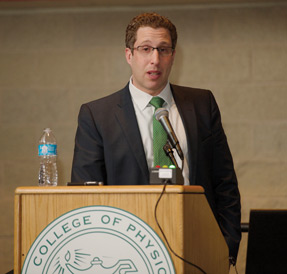For effective smoking cessation, turn ambivalence into action
Smokers sometimes want to want to quit. The ambivalence is the effect of nicotine, which rewires the brain. Instead of being wary of the patient's mixed feelings, use them as a sign to try nicotine replacement therapy systems that make the cravings more manageable.
Frank T. Leone, MD, FACP, said he sees a lot of ambivalence about smoking cessation among the patients in his clinic.
“I want to want to quit,” a patient once told him.

His reaction and advice to attendees of his “Smoking Cessation in Primary Care” at Internal Medicine 2014 was, “Think about smoking as a disorder of motivation: not a disorder that's a deficit of motivation to quit, but rather, as a disorder characterized by excess motivation not to quit.”
Dr. Leone, who is an associate professor of medicine and director of the Comprehensive Smoking Treatment Program at the University of Pennsylvania in Philadelphia, explained how to turn patient ambivalence into action.
He explained that nicotine works on not the conscious part of a person's thinking, but the survival system of the brain located in the cortex to midbrain. Nicotine creates long-term changes in the brain, including:
- an increase in neuronal arborization as the patterns linking neurons to one another are altered,
- an increase in the density of nicotine receptors, and
- changes in gene expression.
Brain cells maintain these changes, which can result in relapses for years after quitting.
And nicotine hijacks these brain systems to create a sense of safety and calm. Taking it away causes a negative reaction, and this is what Dr. Leone says he sees in his clinic.
“It's an uncertainty, a visceral uncertainty that stopping now is the right thing to do,” he said. “So there's a conundrum. The thinking part of [the patient] says to quit, the visceral part of [the patient] says not today. And [the patient] is stuck between those 2 sides going back and forth, back and forth.”
He continued, “I think of this as the cardinal sign of the illness, the same way I think of wheezing as the cardinal sign as asthma or COPD. When I see ambivalence to quit, I'm not afraid of that. I'm not repelled by that. I can't use that as my signal not to treat because it's the cardinal sign.”
He offered suggestions on using drugs and devices to help patients control their urges to smoke using nicotine replacement therapy.
Nicotine patches offer a way to deliver controller medications that may reduce the frequency and intensity of the compulsions to smoke. The urges don't disappear, but they become more manageable, he said.
He suggested starting with a high dose to get control and then tapering it. Package inserts say to taper the patch over 8 to 10 weeks, but there are a lot of data that support treating patients longer for better patient response, he noted. While treating for 6 months is good, Dr. Leone said, doing so for 12 months works as well. Using the patch compared to placebo will increase a patient's sensation of control about 2-fold.
The time frame should be chosen in conjunction with the patient. “If [the patient] is still jonesing at 10 weeks, she's going to come into the office and say should I stop the patch now. That to me is an expression of a misunderstanding on [the patient's] part. She thinks she's supposed to quit, not get control.”
The most common side effect of nicotine patches is local irritation, either from the nicotine itself or the adhesive used on the patch. If it's about the adhesive, the redness will be wider than the patch. If it's the nicotine, the redness will be under the patch. Either way, a little dab of hydrocortisone cream before application will cure those 2 side effects, Dr. Leone said.
Patients who smoke on the patch may ask about smoking while on the patch. In the doctor's mind, that means the patient won't smoke. More likely, it means the patient won't use the patch, Dr. Leone said. Tell the patient regardless of smoking to leave the patch on. “Smoking on the patch results in ... um ... how do you say it? ‘Nothing,’” he said.
Patients using nicotine replacement therapies who continue to smoke change their smoking behavior. They take fewer puffs, they take smaller puffs, and their baseline nicotine levels remain the same, Dr. Leone said.
Gums and lozenges are placed next to the oral mucosa and are used instead of a cigarette when patients want to smoke. They generally increase sensation of control by about 50%. Dr. Leone advises patients to use these products like chewing tobacco, not chewing gum, because chewing releases acid to the stomach and makes the patient feel nauseated. Also, the product doesn't get absorbed and it's rendered useless, Dr. Leone said.
Inhalers aerosolize nicotine to the back of throat via a plastic tube and a liquid nicotine cartridge. There are 450 different versions of these products, which are popular with patients, in the U.S., ranging from options that allow people to mix their own cartridges to disposable units found at convenience stores to much more expensive computerized kits.
“None of them have any data on efficacy, how you use them, or how often you use them,” Dr. Leone cautioned, adding that there are also no safety data about what happens when patients absorb other products they contain, such as propylene glycol, for years of use.
Two drugs started prior to quit attempts may help patients succeed, Dr. Leone said. Bupropion improves odds of sensations of control 2-fold, he said. While package labels say to start the drug 7 to 10 days before quitting, a lot of data suggest using it 4 weeks prior actually works better.
In the clinic, he tells patients to start bupropion and then “Don't quit smoking.”
He added, “I've removed a total obstacle for her not using the medication, because now, it's not about her quitting, it's about how she feels on the inside, and all she has to do is take a pill.”
The same is true for varenicline. While it's prescribed for 1 week prior to quitting, it could require 4 weeks to reach effect. The drug comes in a blister pack marked with an arrow indicating that patients should quit smoking on the seventh day of use. Again, he tells patients to ignore that instruction and to keep smoking until the next check-in. Data suggest that going for a total of 5 weeks helps control later urges to smoke, he said.
Contrary to lay media reports about psychiatric disturbances, varenicline simply doesn't cause them, Dr. Leone said. While the drug was associated with a 10-fold increase in sleep disorders, these can be alleviated by taking the drug with food at breakfast and dinner, and not at bedtime, he noted.




